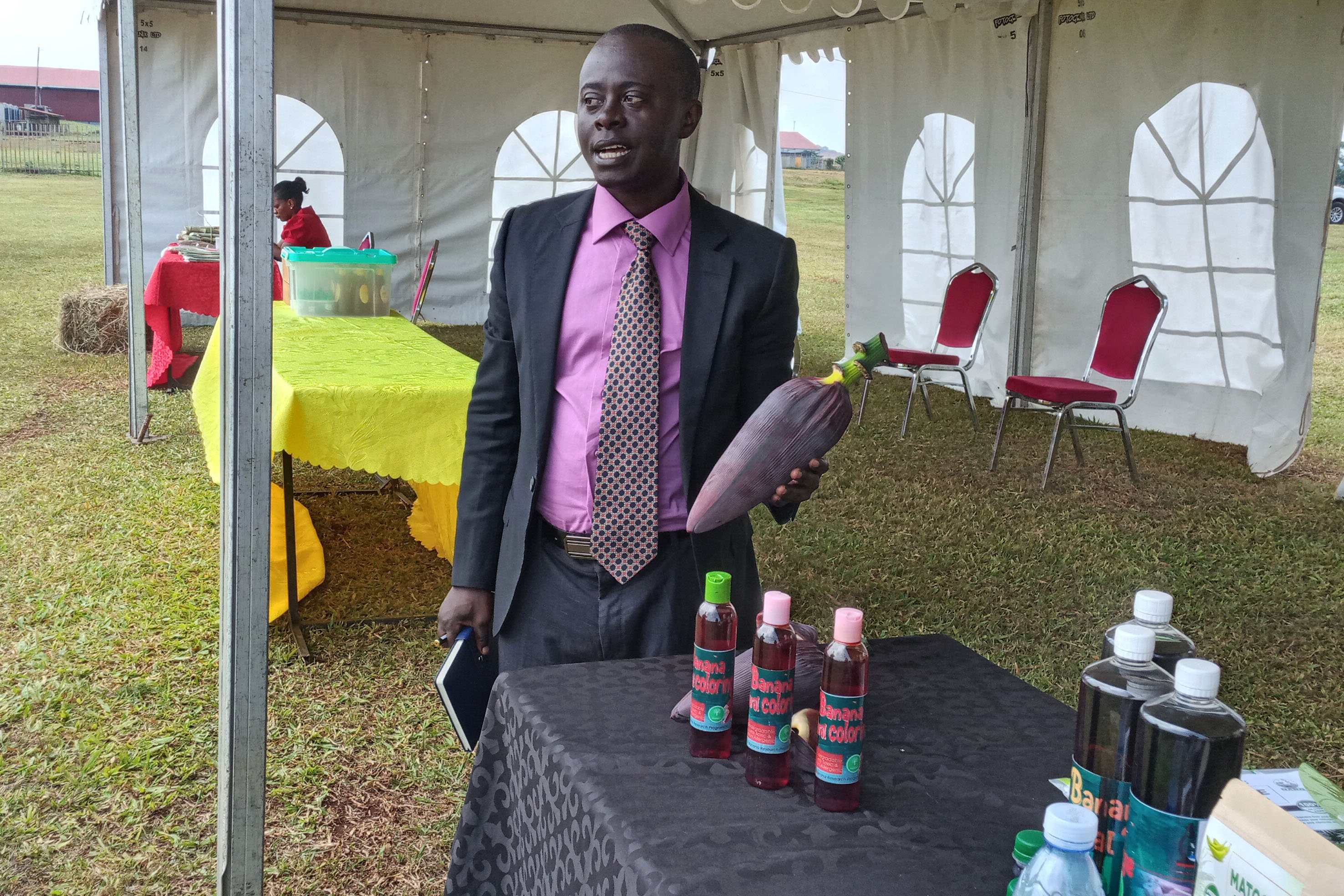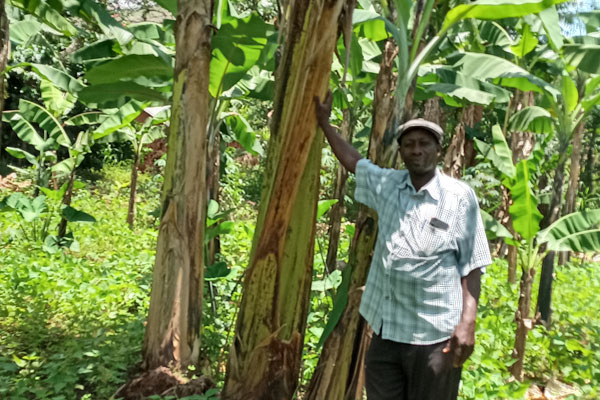Prime
How the banana flower makes tasty vegetable

Mr Yusuf Mukasa of NaRL explains how he extracts useful fluids from the banana purple flower. Photo/Lominda Afedraru
What you need to know:
- The teardrop shaped purple flower at the end of the banana fruit cluster has lots of health benefits that most farmers and consumers do not know about, the reason why many regard it as waste.
As one of the major staple foods in Uganda, the banana is important for providing food and income to producers and other value chain actors.
However, the sector is vastly underdeveloped, hence limiting its contribution to the economic wellbeing of actors Like many developing countries in Africa, agricultural value chains in Uganda are largely underdeveloped.
The banana value chain is among the main agricultural value chains in Uganda. It is characterised by a long chain of actors making the trading system inefficient with brokers getting involved.
As such, banana producers have limited bargaining power since they sell their produce individually, each selling a few bunches at a time.
Opportunities
Nonetheless, farmers have unexploited opportunities including the adoption of improved banana varieties and agricultural inputs such as fertilisers. The value addition aspect is also not being explored.
Farmers can adopt the option of adding value to their banana by processing banana flour, banana chips, banana juice, banana wine and also banana fiber to earn extra income.
As such scientists involved in banana breeding and banana value chain are processing various products for farmer adoption. One of the recent value added products is use of banana bud to develop various liquids used in various forms as food nutrient and for dyeing cloths or any other product.
Seeds of Gold caught up with Yusuf Mukasa the head food processing technology and incubation centre at the National Agriculture Research Laboratories (NaRL) and he explained the process as below.
Processing food colouration ingredient from banana male bud, Mukasa contends that most farmers and consumers of varieties in Uganda are interested in growing banana for the finger to be consumed as ripe dessert and in cooked form.
However banana value addition is true from using the fibre as processed hair material, the fingers for processing banana floor as confectionery material, the starch for processing industrial alcohol and the male bud is consumed as vegetable. The scientists have now gone ahead to process the male bud for food coloration and for dyeing clothes.
Processing procedure
Mukasa explained that banana male bud in most cases is purple in colour and it has special pigments called anthrocynin.
The anthrocynin is medicinal containing antidiabetic properties meaning it can be used to treat diabetes or can be consumed in food by people suffering from diabetes.
It can be added in foods such as boiled milk, boiled vegetables and confectionery products such as bread, biscuits and cakes among others.
It also contains food nutrients namely vitamin A and carotenoid with antioxidant properties and once some consumes food where male bud pigment is added, the person will free stress free.
At the same time people suffering from cancer causing oxidative stress are advised to consume to male bud pigment.
The banana male bud pigment is relatively a new product which has not been rolled out for commercialisation. There are already existing food such as purple fleshed sweet potato rich in Iron, vitamin A and zinc which similar health benefits such as for banana male bud pigment.
Extraction process
What the scientists do is harvest fresh banana male bud mainly from the sweet bogoya (cavendish) banana variety because they contain enough anthrocynin.
It is cleaned by removing the outer cover and washed in clean water. It is then removed and sterilised using food chemicals to avoid disease contamination. It is crushed using a special equipment to form the liquid.
This liquid is extracted using chemical extraction where the chemical will be evaporated and the clean purple pigment is kept in vacuum seal containers.
It is also packaged in vacuum seal containers or bottles. The team has so tested it food such as pizza recipes, purple bread, vegetable soup, tea and milk and the results are effective on human health.
The have also tested in banana juice and other juices. The reason the pigment is extracted from bogoya male bud is to ensure the end product has the sweet bogoya banana flavour.
Since most food flavours are made out of synthetic products, the scientists say it is wise to make the flavour from natural banana male bud which is health for humans.
The team also established that the male bud banana pigment can be used to dye clothes and hair which women use to plait their hair.
This therefore means once the product is commercialised, textile industries dealing dyeing clothes will benefit.
Banana Starch
Mukasa and his team have also developed banana starch from matooke which are packaged in bottles. They have medicinal benefits.
The team extracts banana starch from peeled matooke fingers which are isolated after it is crushed and mixed with water.
The crushed matooke peel meant for food is drained off with the water and white starch which is in small quantities remains stuck under the container. This is collected and dried to obtain powder.
The green starch once consumed is as good as antibiotics which humans use for treating intestinal bacterial infections. Once it is consumed, it takes long to dissolve in the intestine thereby helping in cleaning infections.
It is also advisable to be consumed by people who are diabetic because it helps reduce the glucose in the intestine.
Value addition
Farmers can adopt the option of adding value to their banana by processing banana flour, banana chips, banana juice, banana wine and also banana fiber to earn extra income.
Key fact
Chop each heart into halves and gently wash the pieces using warm salty water to clear the thick sap, which if not well cleaned makes the food bitter.
According to experts, the vegetable has an aromatic flavour and its taste is similar to that of meat, therefore, good for vegans.




